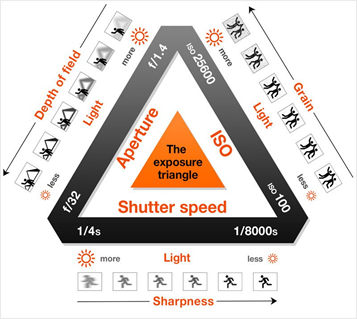The camera, arguably the most important creative instrument in TV can appear quite daunting to a new user however after some practice over the basics, things made more sense.

The main functions we looked at on the Panasonic AC160, were different ways in altering the exposure. We learnt about the exposure triangle and how light is measured in Kelvin on the Kelvin scale, 3200 degrees kelvin being normal tungsten lighting commonly found in indoor spaces and 5500 degrees kelvin being direct summer sunlight at noon which is useful for outside shoots. Knowing these values helps the camera operate alter the white balance to achieve a true white as the lower light measures in Kelvin the warmer it is and the higher, the cooler it is. To fix the white balance the camera operator can hold a white card (if needed, often used on outdoor shoots) or zoom in on a white wall or surface and set the right switch to A or B this will create a custom preset, then they can press the AWB button and the camera should automatically white balance.
ISO/Gain can also be controlled in the same area of the camera, on the left most switch the camera operator can select either L, M or H. L should be used for normal conditions, M or H are if extra lighting is required in the shot however the lighter a shot is made via gain the noisier the image looks.

Iris can also be used to alter the exposure of an image, the iris button when clicked allows the camera operator to turn the dial on the lense and adjust the aperture of the camera, the higher the f/ stop the wider the opening of the lens and so the deeper the depth of field and the lighter the shot is.
The final side to the exposure triangle is shutter speed, to control this the camera operator must turn the shutter speed dial the higher the shutter speed the higher the exposure, however the camera should be kept completely still as it also adds motion blur.
If a shot is particularly over exposed due to sunlight or perhaps snow a Neutral Density Filter (ND filter) can be turned on which act like sun glasses to the camera lens, darkening the image slightly.

These are all the basics that were discussed with regards to exposure and white balance. With regards to other basics surrounding the camera; make sure your battery is always charged and bring backups, make sure the camera is level on the tripod by using the spirit level, to get a steady zoom use servo mode, make sure your shot is always in focus and finally when using the uni’s SD cards format the card before beginning to clear space for your footage.
In my next post I’ll discuss sound and all the tips and advice surrounding that.
Emily
Useful Video: https://www.youtube.com/watch?v=QVCqVe3fmY4